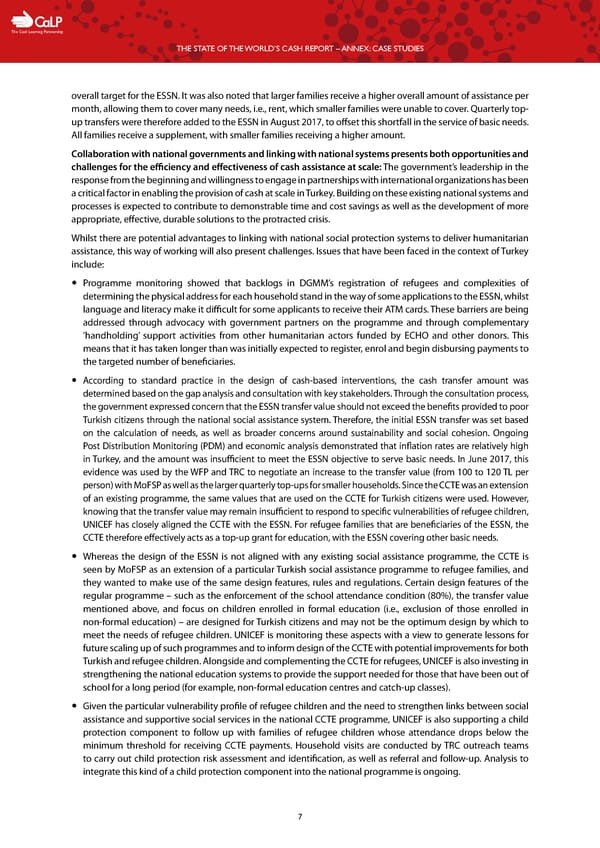C The Cash Learning Partnership THE STATE OF THE WORLD’S CASH REPORT – ANNEX: CASE STUDIES overall target for the ESSN. It was also noted that larger families receive a higher overall amount of assistance per month, allowing them to cover many needs, i.e., rent, which smaller families were unable to cover. Quarterly top- up transfers were therefore added to the ESSN in August 2017, to offset this shortfall in the service of basic needs. All families receive a supplement, with smaller families receiving a higher amount. Collaboration with national governments and linking with national systems presents both opportunities and challenges for the efficiency and effectiveness of cash assistance at scale: The government’s leadership in the response from the beginning and willingness to engage in partnerships with international organizations has been a critical factor in enabling the provision of cash at scale in Turkey. Building on these existing national systems and processes is expected to contribute to demonstrable time and cost savings as well as the development of more appropriate, effective, durable solutions to the protracted crisis. Whilst there are potential advantages to linking with national social protection systems to deliver humanitarian assistance, this way of working will also present challenges. Issues that have been faced in the context of Turkey include: — Programme monitoring showed that backlogs in DGMM’s registration of refugees and complexities of determining the physical address for each household stand in the way of some applications to the ESSN, whilst language and literacy make it difficult for some applicants to receive their ATM cards. These barriers are being addressed through advocacy with government partners on the programme and through complementary ‘handholding’ support activities from other humanitarian actors funded by ECHO and other donors. This means that it has taken longer than was initially expected to register, enrol and begin disbursing payments to the targeted number of beneficiaries. — According to standard practice in the design of cash-based interventions, the cash transfer amount was determined based on the gap analysis and consultation with key stakeholders. Through the consultation process, the government expressed concern that the ESSN transfer value should not exceed the benefits provided to poor Turkish citizens through the national social assistance system. Therefore, the initial ESSN transfer was set based on the calculation of needs, as well as broader concerns around sustainability and social cohesion. Ongoing Post Distribution Monitoring (PDM) and economic analysis demonstrated that inflation rates are relatively high in Turkey, and the amount was insufficient to meet the ESSN objective to serve basic needs. In June 2017, this evidence was used by the WFP and TRC to negotiate an increase to the transfer value (from 100 to 120 TL per person) with MoFSP as well as the larger quarterly top-ups for smaller households. Since the CCTE was an extension of an existing programme, the same values that are used on the CCTE for Turkish citizens were used. However, knowing that the transfer value may remain insufficient to respond to specific vulnerabilities of refugee children, UNICEF has closely aligned the CCTE with the ESSN. For refugee families that are beneficiaries of the ESSN, the CCTE therefore effectively acts as a top-up grant for education, with the ESSN covering other basic needs. — Whereas the design of the ESSN is not aligned with any existing social assistance programme, the CCTE is seen by MoFSP as an extension of a particular Turkish social assistance programme to refugee families, and they wanted to make use of the same design features, rules and regulations. Certain design features of the regular programme – such as the enforcement of the school attendance condition (80%), the transfer value mentioned above, and focus on children enrolled in formal education (i.e., exclusion of those enrolled in non-formal education) – are designed for Turkish citizens and may not be the optimum design by which to meet the needs of refugee children. UNICEF is monitoring these aspects with a view to generate lessons for future scaling up of such programmes and to inform design of the CCTE with potential improvements for both Turkish and refugee children. Alongside and complementing the CCTE for refugees, UNICEF is also investing in strengthening the national education systems to provide the support needed for those that have been out of school for a long period (for example, non-formal education centres and catch-up classes). — Given the particular vulnerability profile of refugee children and the need to strengthen links between social assistance and supportive social services in the national CCTE programme, UNICEF is also supporting a child protection component to follow up with families of refugee children whose attendance drops below the minimum threshold for receiving CCTE payments. Household visits are conducted by TRC outreach teams to carry out child protection risk assessment and identification, as well as referral and follow-up. Analysis to integrate this kind of a child protection component into the national programme is ongoing. 7
 The State of the World's Cash | Case Studies Page 8 Page 10
The State of the World's Cash | Case Studies Page 8 Page 10